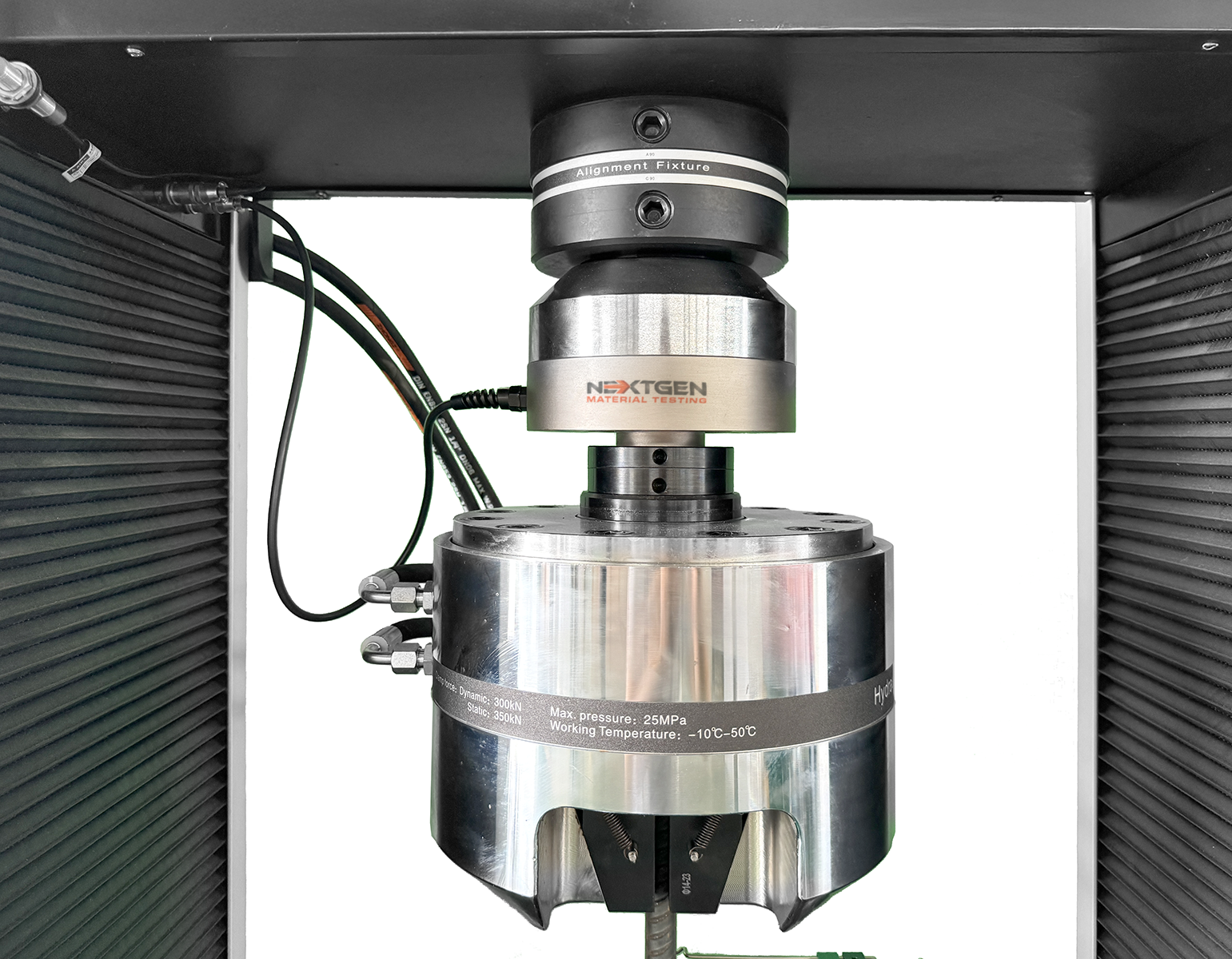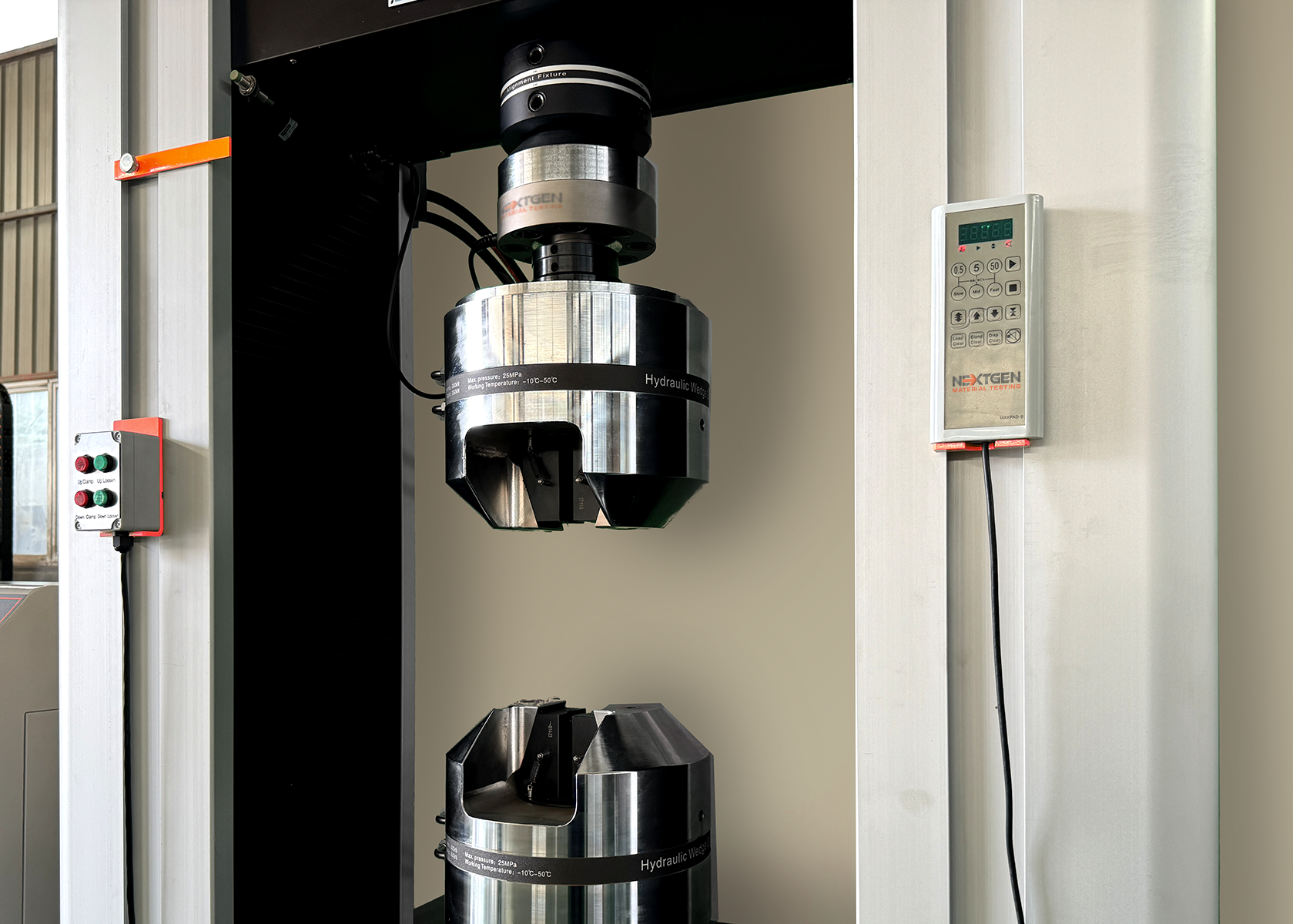Metal Testing Equipment
Standards






Description
NextGen Material Testing’s Alignment Device is a precision-engineered fixture designed to ensure perfect axial alignment in universal testing machines. Originally introduced as an optional add-on for NextGen’s Class D dual-column floor-standing UTM systems, this alignment device has proven so vital for accurate testing that it is now offered as a standalone product. It can be retrofitted onto both NextGen machines and third-party frames (such as popular Instron® models), instantly upgrading them to meet the strictest alignment standards. By fine-tuning the load train coaxiality to within ≤ 5% misalignment, the device eliminates bending stress and off-center loading, resulting in highly reliable and repeatable material test results.
In practice, the alignment device installs between the machine’s crosshead and grips (or fixtures), allowing for initial coarse positioning followed by fine adjustments via an integrated high-precision coaxiality meter. After the initial setup, the system’s coaxiality detection mechanism enables operators to dial in precise alignments, achieving full compliance with alignment standards like ASTM E1012 and NASM 1312B. The outcome is a test frame alignment that meets or exceeds stringent requirements for aerospace and other quality-critical industries. Labs can leverage this device to ensure uniform force application, preventing the subtle bending stresses that can cause premature specimen failures or data inaccuracies. The Alignment Device is compatible with a wide range of load capacities (from low-load testing machines up to high-capacity floor models) and is constructed to be durable and rigid, so alignment is maintained even under maximum loads.
Alignment Device Advantages
-
Precision Alignment (≤5% Coaxiality Misalignment): Achieves exceptionally tight load alignment, minimizing bending and eccentric forces. This level of precision ensures compliance with ASTM E1012 and NASM 1312B alignment standards, which is critical for achieving NADCAP accreditation in aerospace testing labs. The built-in coaxiality meter guides the user to adjust alignment until the load train is virtually perfectly centered.
-
Enhanced Test Result Reliability: By removing misalignment-induced errors, the device delivers accurate and repeatable test outcomes. Engineers can trust that variations in test data are due to material behavior, not quirks of the test frame. This improves the statistical significance of results and reduces the need for re-tests due to suspect data.
-
Versatile Application: The alignment fixture supports tensile, compression, bending, and other test modes without modification. Whether you are pulling metal specimens to failure, compressing aerospace components, or flexural testing composites, the device maintains the coaxial alignment of the specimen throughout the test. This versatility makes it suitable for labs dealing with multiple types of mechanical tests.
-
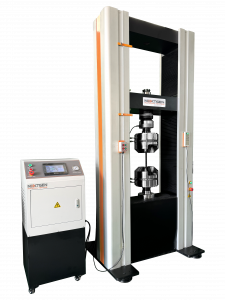 Cross-Platform Compatibility: Designed for universal adaptability, the NextGen alignment device can be installed on NextGen’s own Class D UTM machines as well as third-party testing machines (e.g., Instron). Its mounting system and adjustment interfaces are standardized, allowing seamless integration with most universal testing frames. This protects your investment – you can use the same alignment tool across different machines in your lab, or even if you upgrade equipment.
Cross-Platform Compatibility: Designed for universal adaptability, the NextGen alignment device can be installed on NextGen’s own Class D UTM machines as well as third-party testing machines (e.g., Instron). Its mounting system and adjustment interfaces are standardized, allowing seamless integration with most universal testing frames. This protects your investment – you can use the same alignment tool across different machines in your lab, or even if you upgrade equipment. -
Standards Compliance & NADCAP Readiness: Using this device helps laboratories conform to the highest international testing standards (ASTM, ISO, DIN, etc.) and meet specific alignment criteria set by programs like NADCAP. In fact, integrating this fixture enables labs to be “NADCAP ready,” since it ensures the alignment calibration required during audits is in place. The device directly addresses requirements from standards such as ASTM E1012 (verification of testing frame alignment) and ISO 23788 (alignment of fatigue testing machines), and helps satisfy audit criteria (e.g., NADCAP AC7101/AC7122 for materials testing) by keeping alignment error within permissible limits.
-
Improved Operator Efficiency and Confidence: The alignment process is straightforward and quick. After installation, operators can perform alignment verification in-house without lengthy downtime. The device’s coaxiality indicator provides immediate feedback, saving time compared to trial-and-error methods or the need for external alignment services. With confidence in the alignment, engineers can focus on the test itself rather than worrying about equipment setup.
Importance of Precise Alignment in Testing
Even slight misalignments in a test system can dramatically affect the outcome of material tests. If the test specimen is not perfectly aligned with the machine’s loading axis, it will experience uneven stress distribution. Misalignment causes the specimen to bend under load, creating strain “hot spots” near the gripping points and leading to premature failure at the grips. In a tensile test, for example, a misaligned specimen often breaks at or near the grip faces instead of the gauge length, indicating that bending stress, not just axial tension, contributed to the failure. These unintended bending stresses not only cause early breakage but also distort the measured results – the material may appear to have a lower elongation or strength than it actually does, due to the added bending component. In short, poor alignment can mask the true behavior of the material.
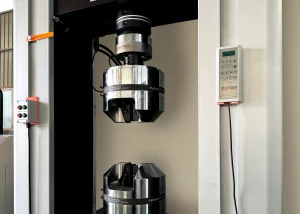
Without a precision alignment device, labs may find that stiff or brittle materials frequently fracture outside the expected gauge region at seemingly low loads. This is a classic symptom of misalignment: the specimen is effectively being stressed in a combination of tension and bending, causing it to fail earlier than it should. Such failures and data are not reliable for analysis or certification. Moreover, non-uniform force application violates the assumptions of many testing standards, potentially putting a lab out of compliance. ASTM and ISO testing protocols assume that the force is applied axially; if that is not the case, the calculated material properties (like tensile modulus, yield strength, etc.) can be significantly in error. Engineers in aerospace, automotive, and metallurgical fields are particularly sensitive to these issues because even minor data inaccuracies can lead to improper material selection or unexpected component failures in service.
From a quality and accreditation standpoint, precise alignment is not optional – it is mandatory. The ASTM E1012 standard was developed specifically to address this: it outlines how to verify and quantify the alignment of a testing frame because industry studies showed that misalignment-induced bending can seriously skew test results. In aerospace and defense testing, the NADCAP program similarly requires proof of proper alignment as part of its Materials Testing accreditation. During NADCAP audits, laboratories must demonstrate that their tensile or fatigue test frames have been aligned within allowed tolerances (often using strain-gauged specimens per ASTM E1012 or similar methods). Failure to control alignment can result in audit non-conformances, meaning the lab cannot achieve or maintain NADCAP accreditation until the issue is fixed.
This is why an alignment device is so critical. By using NextGen’s Alignment Device, labs ensure uniform, axial loading of test specimens, which improves result reliability and repeatability dramatically. It eliminates one of the biggest hidden variables in materials testing. When alignment is taken care of, any variations in test results are truly due to material differences or natural scatter – not an artifact of test setup. This not only boosts confidence in the data but also means labs can meet the requirements of strict standards and customer specifications (for example, NADCAP or OEM mandates that tests be done under aligned conditions as per ASTM E1012).
Standards Compliance and NADCAP Integration
The Alignment Device is engineered to help your lab meet key industry standards and accreditation requirements related to testing machine alignment:
-
ASTM E1012 – Standard Practice for Verification of Testing Frame and Specimen Alignment. This device enables you to verify and adjust frame alignment in accordance with ASTM E1012, ensuring that any bending strain in the specimen is within the allowable percentage. By achieving a coaxiality of ≤5% during setup, you’re directly adhering to ASTM E1012 guidelines for minimal misalignment. The result is reduced measurement error in tensile, compressive, and fatigue tests, as required by this standard.
-
NASM 1312B – This is a specification derived from aerospace requirements (originally stemming from MIL standards) that also demands strict alignment in fastener and material testing. The NextGen alignment fixture meets the NASM 1312B criteria for coaxial loading, which means it’s suitable for use in testing scenarios governed by this aerospace methodology. In practical terms, if your projects or contracts reference NASM 1312 series test methods, this device will ensure your setup complies.
-
DIN / ISO Standards – Many European and international standards emphasize proper alignment (for example, ISO 23788 for fatigue test machine alignment and parts of ISO 6892 and DIN 50100 series for tensile testing procedures). Using the alignment device helps laboratories conform to these global standards by maintaining the alignment within specified limits. This is important for multinational companies or those selling to global markets, as compliance with DIN and ISO standards is often required. The device’s capability to reduce misalignment to negligible levels supports adherence to the alignment verification guidelines found in these standards, ensuring that tests conducted are valid under ISO/DIN criteria.
-
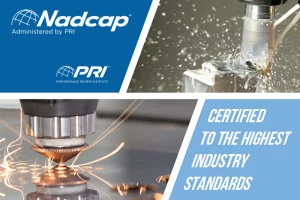 NADCAP (National Aerospace and Defense Contractors Accreditation Program) – For labs seeking NADCAP accreditation in materials testing, alignment measurement is a mandatory component. NADCAP audit checklists (AC7101 for materials testing laboratories, and AC7122 for nondestructive testing, etc.) include verifying that test frames meet alignment tolerances (often referencing ASTM E1012 as the method). NextGen’s Alignment Device is NADCAP-ready by design – it was developed specifically to help labs pass the stringent NADCAP alignment requirements. By ensuring your tensile or compression frame is aligned within ≤5% bending, the device reduces testing variability and helps you meet NADCAP audit requirements with confidence. When installed, it provides documented evidence of alignment control, which you can present during audits to demonstrate compliance. For detailed information on how NextGen equipment supports NADCAP compliance, please refer to NextGen’s Accreditation and Certification of Testing Equipment page, which outlines our commitment to industry standards and includes our NADCAP alignment solutions.
NADCAP (National Aerospace and Defense Contractors Accreditation Program) – For labs seeking NADCAP accreditation in materials testing, alignment measurement is a mandatory component. NADCAP audit checklists (AC7101 for materials testing laboratories, and AC7122 for nondestructive testing, etc.) include verifying that test frames meet alignment tolerances (often referencing ASTM E1012 as the method). NextGen’s Alignment Device is NADCAP-ready by design – it was developed specifically to help labs pass the stringent NADCAP alignment requirements. By ensuring your tensile or compression frame is aligned within ≤5% bending, the device reduces testing variability and helps you meet NADCAP audit requirements with confidence. When installed, it provides documented evidence of alignment control, which you can present during audits to demonstrate compliance. For detailed information on how NextGen equipment supports NADCAP compliance, please refer to NextGen’s Accreditation and Certification of Testing Equipment page, which outlines our commitment to industry standards and includes our NADCAP alignment solutions.
In summary, the Alignment Device acts as an insurance policy for your testing process: by meeting or exceeding all these standards, it ensures that your lab’s test data will be accepted in regulated industries. Whether it’s an internal quality system audit, a customer inspection, or a formal accreditation process, having this alignment fixture in place signals that your lab takes accuracy seriously and has the tools needed to prove it.
Contact for Estimate
Ready to elevate your testing accuracy and compliance? Contact NextGen for an Estimate – our team will be happy to discuss your needs and provide a tailored quote. Request a consultation or quote through our online form, and take the next step toward NADCAP-ready precision in your lab.
FAQs
Proper alignment ensures that the load is applied straight through the specimen’s axis. Misalignment leads to non-uniform stress, causing strain concentrations and premature specimen failure near the grips. If a specimen isn’t aligned, you might see it bending during the test or breaking at lower loads than expected, which invalidates the results. In essence, good alignment is crucial for obtaining true material behavior and reliable data.
Common signs include specimens consistently fracturing at the grip faces or one side of the specimen necking more than the other. If you notice the specimen bending or see an uneven gap between the specimen and one side of the grips under load, the frame is misaligned. Data-wise, large variability in results or abnormally low strength/elongation can also indicate misalignment issues, since bending stresses lead to earlier failure.
Misalignment can significantly skew test results. It introduces bending stress on top of axial stress, so the material may appear to have a lower tensile strength or modulus than it actually does. Results become less repeatable, as different specimens might bend in different directions. Essentially, you get inaccurate measurements and higher scatter in data, which can make it difficult to certify materials or compare results. By using the Alignment Device to ensure a straight loading path, you improve the accuracy and repeatability of your measurements, giving you tighter data consistency.
Yes. Standards like ASTM E1012 set limits on allowable misalignment, and if your machine exceeds those, any tests performed may be considered non-compliant. For example, in a NADCAP audit for materials testing, auditors will require evidence that your frame’s alignment is within acceptable limits. If you lack documentation or tools to prove this, it could result in a non-conformance. Poor alignment could also mean you’re inadvertently violating specifications of test standards (ASTM, ISO, DIN) that assume axial loading. In short, a misaligned machine can cause you to fail compliance checks and require corrective action.
ASTM E1012 is the standard practice for verifying the alignment of a testing frame under load. It typically involves using strain-gauged specimens to measure bending strain as a percentage of axial strain. NextGen’s Alignment Device helps you meet ASTM E1012 by providing a means to adjust the frame so that bending strain is minimized. The device’s adjustments and coaxiality meter enable you to get the misalignment error down to ≤5% (or better) of axial strain, which is within the tolerance ASTM E1012 requires. Essentially, it gives you a practical way to comply with E1012 without trial-and-error – once installed, you can quickly tune your machine alignment to standard-approved levels.
NASM 1312B is part of a series of National Aerospace Standards for material and fastener testing (originally stemming from military standards). It includes requirements for how tests like tension should be performed – including alignment criteria – especially for aerospace-grade fasteners and materials. If you work with aerospace components or contracts that reference NASM standards, you need to ensure compliance. The Alignment Device is built to satisfy the alignment accuracy called for in NASM 1312B, so it will help you meet those specifications. Even if you’re not directly using NASM methods, this highlights that the device meets very strict aerospace requirements, which is a good indicator of overall alignment quality.
Yes, many international standards emphasize proper alignment as part of the testing procedure. For instance, ISO 23788 is an international standard specifically for verifying alignment of (fatigue) testing machines, and ISO 6892 (metallic materials tensile testing) implies the need for axial loading to get valid results. DIN standards (German standards, often aligned with ISO) also incorporate alignment – for example, DIN EN ISO 7500-1 (for verification of test machines) and others ensure the machine’s force application is axial. While the exact methods can differ, the common theme is that machine alignment must be checked and kept within a tolerance. By using the alignment fixture, you’re essentially addressing these requirements proactively. It gives you confidence that whether it’s an ASTM, ISO, or DIN based test, your setup is within the accepted alignment criteria.
Even if you are not seeking NADCAP, precise alignment is still crucial for test fidelity. NADCAP is just one (very strict) example – the aerospace industry demands it. But any lab that values accuracy and credible results should ensure alignment. If you publish test data, supply to customers, or certify materials, having misalignment in your system can lead to misleading data or customer pushback. Furthermore, other quality systems (ISO 17025 lab accreditation, internal QA programs) require control of all factors affecting a test. The alignment device therefore isn’t just about NADCAP; it’s about good scientific and engineering practice. It will improve the quality of your results for any application, from academic research to automotive QA to steel mill tensile tests.
Yes. The NextGen Alignment Device is designed to be universal and compatible with most dual-column universal testing machines. It can be adapted to another machine’s crosshead and grip interface. In fact, many labs choose this device to upgrade older machines or non-NextGen frames so they can achieve NADCAP-quality alignment without buying an entirely new tester. The installation may involve using an adapter or plate to mount the fixture on the third-party machine, but it is straightforward. We specifically emphasize compatibility with major brands like Instron, MTS, Zwick/Roell, etc., so that you can get the benefits of precise alignment on whatever equipment you have.
Not at all. The device is designed for easy installation and operation. Typically, it mounts between the machine’s moving crosshead and the load fixture (grips). A technician or engineer can install it in a short time, using basic tools. Once mounted, performing the alignment is user-friendly: the device includes an indicator (coaxiality meter or alignment gauge) that shows the angular/alignment error. By following the adjustment procedure (usually tightening or loosening certain fine adjustment screws on the fixture), you can zero out the misalignment reading. NextGen provides documentation and guidance for the process. After an initial coarse alignment, the built-in coaxiality detection system guides you to achieve fine alignment, so no special training is required beyond standard UTM operation skills. Many users report that after using it a few times, checking and adjusting alignment becomes a quick routine task before critical tests.
It depends on how frequently you change fixtures and the criticality of your tests. A good practice is to verify alignment whenever you set up a new test configuration (for example, changing from a tensile wedge grip to a compression platen could slightly affect alignment, so you’d check it then). The alignment device makes this easy – a quick check with the meter will tell you if anything is off. For labs under strict quality control, verifying alignment daily or weekly can be part of the routine (it only takes a few minutes). The device is stable, so you shouldn’t need to adjust it unless something in the load train changes or the machine has undergone maintenance. During machine calibration cycles (e.g., annual service), it’s wise to do an alignment check as well. In summary, regular quick checks are recommended, but large adjustments are rarely needed once the device is in place and your setup is consistent.
Labs that lack a proper alignment tool often encounter several pain points:
- Inconsistent results: Without eliminating misalignment, you might see a higher scatter in your data, requiring more repeat tests to verify trends.
- Frequent specimen failures at grip: As mentioned, misalignment causes specimens to break at the grips, which means wasted samples and unclear results (was it the material or the setup?).
- Difficulty meeting standards: You may find it challenging to prove compliance with standards like ASTM E1012. If a customer asks for evidence of alignment calibration, you wouldn’t have it readily available.
- Audit/Certification hurdles: If pursuing any lab accreditation (ISO 17025) or trying to win aerospace contracts, the lack of an alignment system could be a red flag. Auditors or clients might require you to demonstrate how you control alignment.
- Hidden equipment strain: Misalignment not only affects specimens but also puts eccentric loads on your machine’s crosshead and bearings, potentially increasing wear and tear. Over time this can lead to higher maintenance costs or equipment drift. Using the alignment device helps ensure forces go where they’re supposed to – through the specimen, not into bending the frame.
By addressing these issues, the alignment device essentially solves the root cause. It brings consistency, clarity, and compliance to your testing process.
By removing alignment as a variable, each test you perform is under very similar loading conditions. This means when you test multiple specimens of the same material, the results should cluster tightly, reflecting true material behavior. In statistical terms, you reduce the standard deviation of your measurements caused by setup variability. NextGen’s alignment fixture specifically reduces testing variability by ensuring coaxial loading. The outcome is that you can trust comparisons – for example, differences between two heat-treat batches or two material suppliers – because you know the test frame wasn’t inadvertently introducing bias. This is especially beneficial for high-volume testing labs or those doing quality control, where consistent results are critical for deciding if a material lot passes or fails.
All axial tests (tension, compression, bending, fatigue) benefit from proper alignment, but it’s especially crucial for:
- Tensile tests of high-strength or brittle materials: Brittle metals, ceramics, or composites have almost no tolerance for bending. Even a small misalignment can cause them to shatter at the grips. The alignment device ensures these materials are tested fairly, often preventing grip fractures and capturing the true tensile strength.
- Low-cycle fatigue tests: When applying cyclical loads, misalignment can initiate unintended bending fatigue, causing early failure not due to axial fatigue but due to the bending component. Proper alignment is required by standards (like ISO 23788) for fatigue testing to get valid life data.
- Compression tests on slender specimens: If you compress a column or rod, any misalignment can cause it to buckle to the side. The device helps ensure the platens are perfectly parallel and centered, so you measure compressive strength rather than bending or buckling.
- Bend fixture setups: For 3-point or 4-point bending, alignment of supports and loading noses is key to uniform stress. While this device is primarily for aligning the load train of the machine itself, the philosophy extends to fixture alignment. Using the machine alignment device ensures the overall frame is plumb and level, which in turn makes setting up bend fixtures easier and more accurate.
In short, any test where off-axis loading could alter the outcome will see an improvement. Most standardized test methods assume ideal alignment, so using this device helps make that assumption true in practice.
Related Products
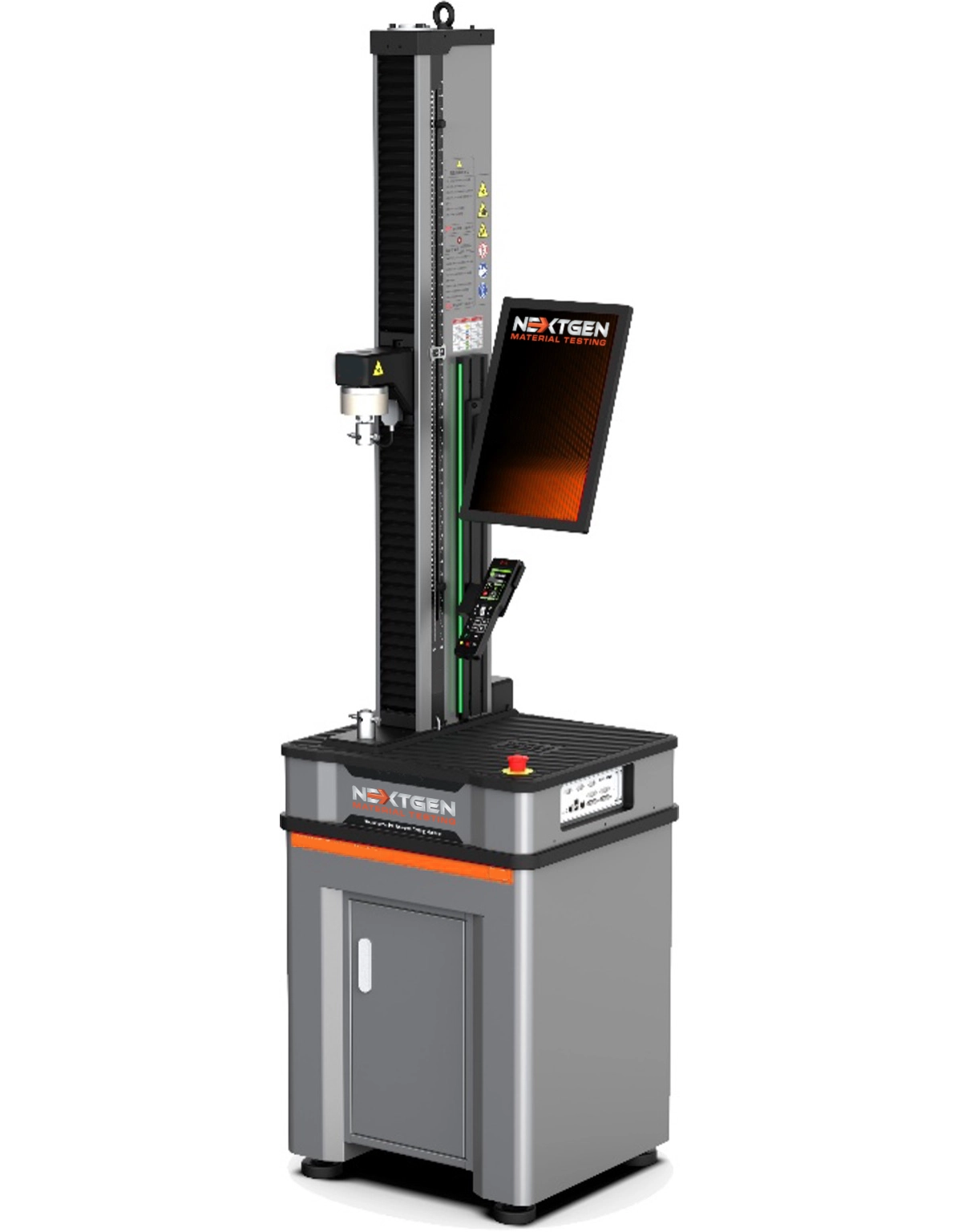
NG-EML Series A – Single Column Bench Top Universal Testing Machine (50 N – 5 kN)
The NG-EML Series A – Single Column Bench Top UTM (50 N–5 kN) is a precision electromechanical system designed for tension, compression, and flexural testing of low-force specimens. Featuring GenTest™ software, a high-speed servo drive, Class 0.5 accuracy, and USB/Ethernet control, this compact tabletop unit supports ASTM, ISO, and EN standards. Ideal for testing plastics, rubber, foams, films, composites, and thin metals.

NG-EML Series B – Dual Column Bench Top Universal Testing Machine (100 N – 10 kN)
The NG-EML Series B is a high-precision dual-column benchtop universal testing machine engineered for tensile, compression, and flexural testing in the 0.1 kN to 10 kN range. It features Class 0.5 accuracy, a rigid FEM-optimized frame, and a direct-drive servo system with advanced closed-loop control, making it ideal for testing rubber, plastics, metals, composites, and high-performance polymers in both R&D and quality assurance settings.
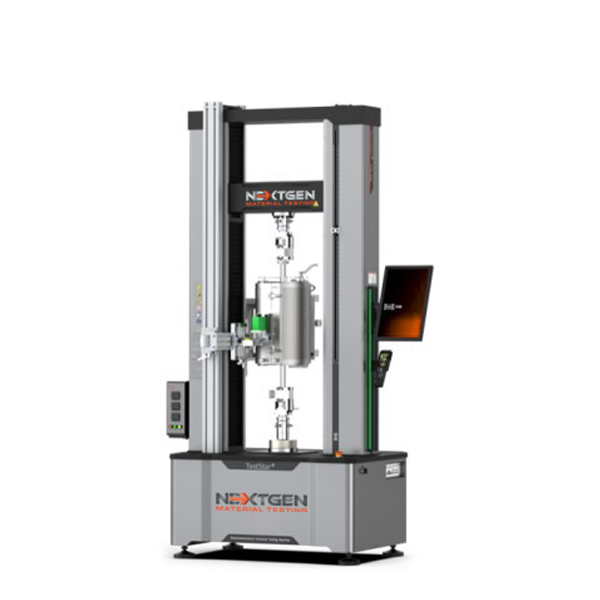
NG-EML Series C – Dual Column Bench Top and Floor Standing Universal Testing Machine (5 kN – 50 kN)
The NG-EML Series C is a precision-engineered dual-column universal testing machine for tension, compression, and flexural testing of metals, composites, rubbers, and polymers. Available in both bench-top and floor-standing formats, with force capacities from 5 kN to 50 kN and Class 0.5 accuracy.
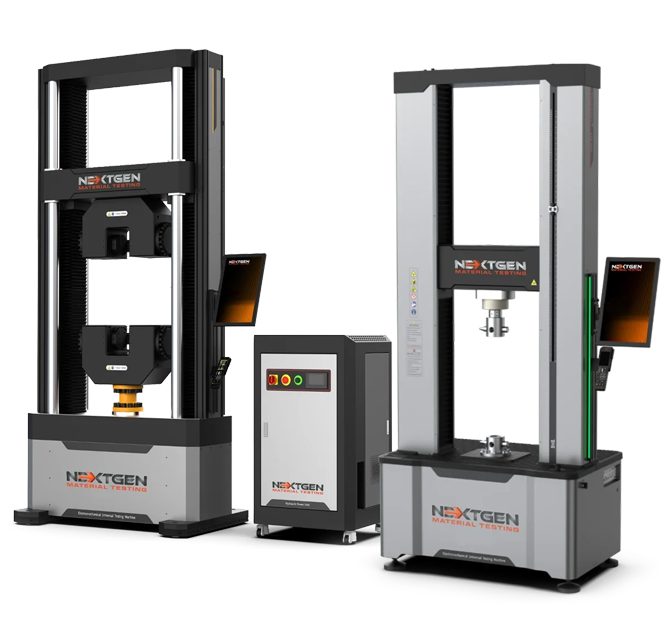
NG-EML Series D – Floor Standing Universal Testing Machine (50 kN – 1000 kN)
The NG-EML Series D – Floor Standing Universal Testing Machine (50 kN–1000 kN) is a dual-column system for tensile, compression, flexural, shear, and cyclic testing of high-strength metals, composites, polymers, and advanced materials. Available in single-space and dual-space configurations, it meets ASTM E8, ISO 6892-1, ISO 527, and GB/T 228 standards. With closed-loop control, 1200 Hz sampling, ultra-low speeds (0.00005 mm/min), and waveform generation, it is ideal for aerospace, automotive, construction, and research labs.

Grips and Fixtures for NextGen Universal Testing Machines (UTMs)
NextGen's grips and fixtures are precision-engineered accessories that transform universal testing machines into versatile systems capable of tensile, compression, flexural, shear, and other mechanical tests. Designed to meet ASTM and ISO standards, these components ensure accurate, repeatable results across various materials and applications.
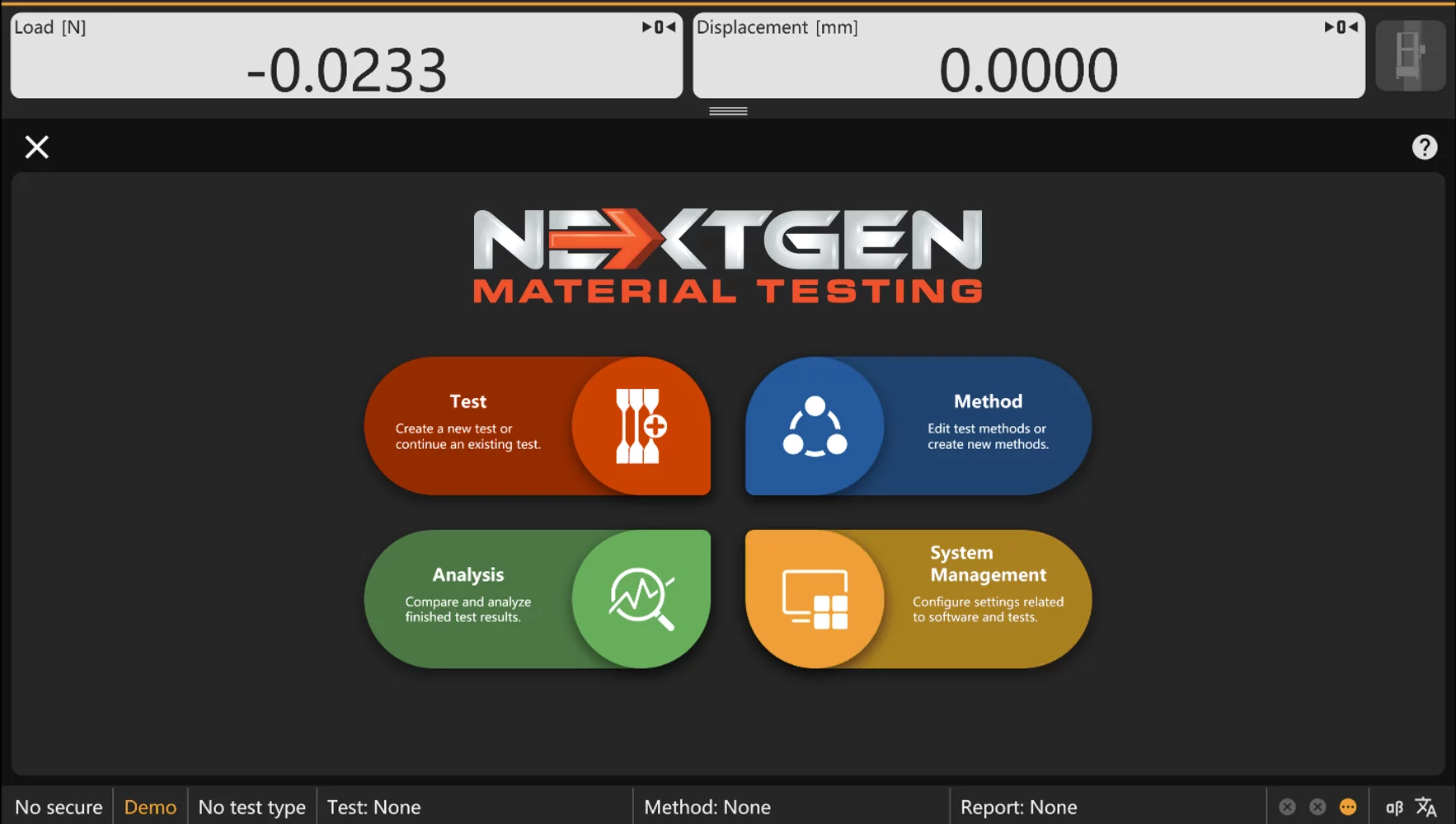
GenTest Data Acquisition Software - Advanced Universal Testing Machine Software
Upgrade to GenTest, the latest data acquisition software for universal testing machines. Ensure precise, repeatable material testing with an intuitive interface, powerful analysis tools, and full compliance with ASTM, ISO, DIN, and more.

NG-SHM Series A — Servo-Hydraulic Universal Testing Machines (300 kN – 3000 kN)
NG-SHM Series A is a high-force servo-hydraulic UTM for static tensile and compression testing of metals. Capacity options from 300 to 3000 kN support oversized round and flat specimens beyond electromechanical limits. The dual-zone configuration enables tension on the upper head and compression on the lower platen without fixture changeover. GenTest software offers standards-based method libraries, real-time curves, automatic calculations, and exportable reports. The system is built for ASTM/ISO metal strength testing in heavy industrial and research environments.
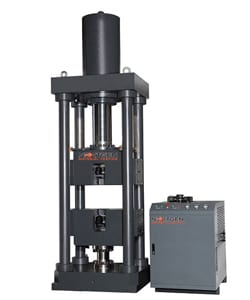
NG-SHM CLASS DP - Servo Hydraulic Testing Machine
600kN-2000kN - Servo-Hydraulic Universal Testing Machine - Side Action Wedge Grip 2/4 columns, servo-controlled hydraulic
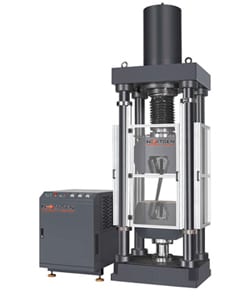
NG-SHM Class D - Servo Hydraulic Universal Testing Machine
600kN-2000kN - Servo-Hydraulic Universal Testing Machine 2/4 columns, servo-controlled hydraulic
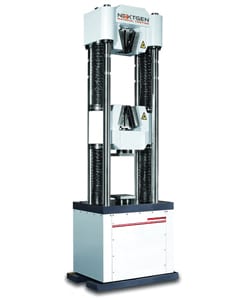
NG-SHM Class C - Servo Hydraulic Testing Machine
600kN-1000kN - Servo-Hydraulic Universal Testing Machine 6 column, servo-controlled hydraulic
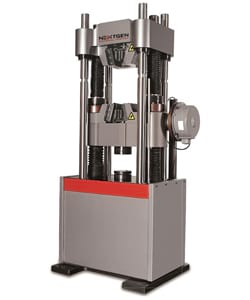
NG-SHM Class B - Servo Hydraulic Testing Machine
300kN-3000kN - Servo-Hydraulic Universal Testing Machine 6 column, servo-controlled hydraulic

GenTest v3.0: Advanced Testing Software for Servo-Hydraulic Universal Testing Machines
Gentest is designed to enhance your ability to perform accurate and repeatable mechanical testing of materials, components and finished goods across a full spectrum of applications.
